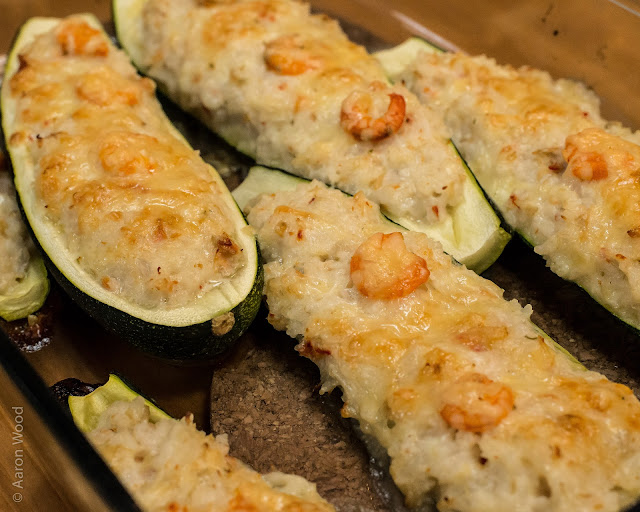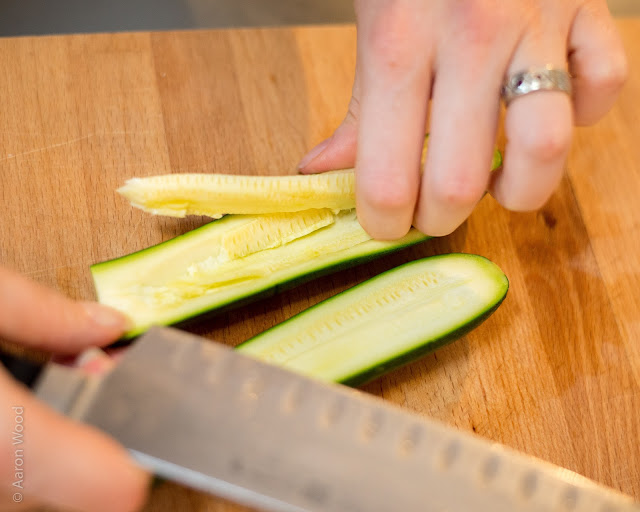
Being up to my eyeballs in my dissertation continues to put my blogging mostly on hiatus (I'll be done in December!), but a woman's gotta eat, and if you gotta eat, you might as well cook, right? (And if your husband wants to try out his new camera lens, he might as well take food pics... It's a slippery slope.)
The French seem to love to stuff things, and I am learning to love it too. It's a nice way to compose a balanced dish, putting rich meats and sauces in with vegetables, keeping leaner meats from drying out, and stretching pricey ingredients with a bit of cheap starch and veggies. And, of course, it looks cool.
Zucchinis in France are more commonly stuffed with ground meat, rice and tomatoes, but Brittany is famous for its creamy seafood dishes, which I love and wanted to do homage to. The sweet mild zucchini complements the crab meat, and since zucchini comes in a variety of sizes, you can make one for every appetite, from toddler to full grown man.
I made this starting from a risotto base, because I wanted leftover risotto for something else. But if you're time pressed, feel free to skip that step and just saute the onion, then toss it with any sort of cooked rice, even Uncle Ben's.
Courgettes Farcies
Servings: 3
Time: about 45 minutes
Planning Ahead: None, aside from shopping
The Funny Stuff: Crab meat and cooked shrimp, Boursin
Virtues: More vegetables, more better. Creamy, cheesy, gooey goodness.
Downsides: Labor intensive
Calories: ~475

Ingredients
Some zucchinis (I stuffed two big and one tiny, but you could do three medium zukes, or 5-6 tiny ones.)
2 Tbsp olive oil
1/2 cup white wine (optional)
1/2 c. dry rice (I used arborio, but you can use anything other than glutinous rice)
1/2 large onion, diced
1 can of crab meat
1 c. cooked shrimp
3 Tbsp. creme fraiche
3 Tbsp. Boursin cuisine (or Boursin spread mixed with extra creme fraiche)
1/2 cup Gruyere or Comté
Directions
Start by making risotto. Warm the olive oil over medium-low heat in a sauce pan, and then add the rice. Stir it until the grains start to turn a little translucent around the edges, then add the onion, and cook it until it's also transparent.

Dump in the white wine, and stir vigorously.

Once the white wine has been almost fully absorbed, add 1/2 cup water, and stir thoroughly. You'll continue to add water 1/2 cup at a time and stir, every time it starts running low on liquid, while you're working on the other steps.

Slice the zucchinis in half lengthwise...

Score the zucchinis deeply with a knife, making a rectangle all the way around the seed area.

Pop the seed area out with your fingers. If you're feeling thrifty, throw them in the freezer and save them for soup. (I'll give a foreigner's guide to French soup making in the next post.)

Once you've got the guts out of the zucchini, microwave them on high for about 6 minutes to start the cooking process along. While you're at it, start preheating your oven to "really quite warm" (which for me was 220 C., or about 425 F.)
If you've been adding water all along, your risotto should be looking something like this, with nice plump distinct grains that are soft to the tooth. (If not, cook it a bit longer.)

Take the half-cooked zucchinis, and lay them in a baking dish or on a cookie sheet. Lay a few shrimp in the bottom of each one.

Put the risotto (or cooked rice and sauteed onion), the crab meat, the creme fraiche, and the Boursin all together in a big bowl.

Grate about 1/4 cup Gruyere or Comte over the top, and then mix everything together.

Spoon the stuffing into the hollow of the zucchini.

Lay the remaining shrimp on top, and sprinkle the other 1/4 cup of grated cheese over the top.

Stick them in the oven, and pull them back out again when they're golden brown on top (about 15-20 minutes). If they're not as brown as you'd like at 20 minutes, give them a minute or two under a broiler.

Enjoy!
All photo credits to Aaron Wood